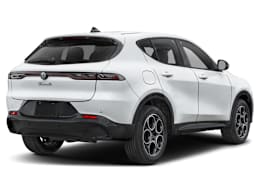Based on the same aging Fiat platform as the underwhelming Jeep Compass and the Dodge Hornet, the Alfa Romeo Tonale small luxury SUV comes standard with a 2.0-liter turbocharged engine and all-wheel drive. It is also offered as an all-wheel drive plug-in hybrid electric vehicle (PHEV), which is the version we tested here.
PHEVs operate like a hybrid, but they have a larger battery and can be plugged into a wall outlet or an EV charger. When the battery is fully charged, they can run on mostly electric power (typically for about 20 to 40 miles, depending on the vehicle) until they switch to regular hybrid operation.
The Tonale’s plug-in hybrid powertrain works well for the most part. There’s plenty of acceleration on hand when you need it, and we appreciate the ability to cover a typical daily commute on electric power (provided it’s charged often), along with decent fuel economy when operating as a hybrid. The front seats are comfortable with fantastic lateral support for holding you in place through fast corners.
But the Tonale’s stiff suspension makes for a rough ride, and it isn’t particularly sporty through the twisty bits. In fact, the more we drove it the more we found ourselves wondering where the typically-satisfying Alfa Romeo steering and handling were, or why the exhaust note wasn’t the least bit invigorating. Then there’s the loud cabin, and a variety of frustrating controls.
Simply put, the Tonale isn’t up to the performance standards expected of the brand, whether compared with the Giulia sedan and Stelvio SUV, or even Alfa Romeos of yore. What’s worse is that the Tonale feels way too much like the (incredibly similar and less expensive) Dodge Hornet.
“Clearly this is a cheap car and a victim of badge engineering,” said one of our testers. “There is nothing Alfa-ish about this SUV. No sharp handling, exciting engine sound, or sexy styling. Sorry, but a start button on the steering wheel, phone-dial-type wheels, and an Italian flag emblem in the cabin don’t cut it.”
Go easy on the accelerator pedal and the Alfa can cover 33 miles on electric power (according to the EPA) delivered to the rear axle, after which it engages a 1.3-liter turbocharged four-cylinder engine to drive the front wheels. The combined 285 horsepower ensures quick acceleration, with 0 to 60 mph in just 6.3 seconds—that’s quick for the class. When the electric power is depleted, the SUV operates as a conventional hybrid, and achieved an efficient 29 mpg overall. However, the Tonale’s tiny 11-gallon gas tank means that you will have to stop frequently for gas on a long drive.
Although the hybrid system transitions pretty seamlessly back and forth between electric and gas power, there are some oddities to the power delivery. For example, when functioning as a hybrid there can be a big power delay taking off from a stop. Then there’s the way the engine sometimes revs abnormally high while sitting at a stop light—this is the system’s way of keeping the hybrid battery charged to a certain level.
Further, if the Tonale is running on electric power and you step harder on the accelerator pedal while powering through a turn, the gas engine will kick on suddenly if the system determines there isn’t enough EV power to handle your request. This delivers a disconcerting—but not dangerous—burst of power to the front wheels.
Handling is secure, showing strong cornering grip when pushed hard around our track. But in terms of everyday driving (whether on a highway onramp or a curvy road), where steering feedback and response are key for communicating agility and confidence, the Tonale doesn’t stand out and feels rather mundane to drive. What’s worse, we found the ride stiff and choppy. The SUV bounces up and down over bumps like you’re riding a pogo stick—minus the fun. On the bright side, the Tonale exhibited competitively short panic-brake stopping distances.
Although cabin quietness benefits from the ability for the Tonale to run solely on electric power at times, the rear electric motor groans during regenerative braking, and we noted unusually high levels of road and wind noise. At least the body-hugging front seats are comfortable and supportive, and we appreciate the standard four-way power lumbar adjustment for both driver and passenger. Unfortunately, the left footrest is positioned too close to the driver, making for an oddly asymmetrical position because the driver’s right leg is much further forward to press on the accelerator pedal. Plus, several drivers found that they had to raise the steering wheel higher than they liked in order to see the entire instrument cluster, putting the wheel at an awkward, bus-like angle.
The rear seat has adequate headroom and good foot space, but the seatback is pretty upright and can’t be reclined—a convenience found in many other SUVs. The Tonale’s narrowness also adversely affects cargo space.
Interior quality is a bit low-rent considering the price, with many hard plastic surfaces. As a member of the Stellantis conglomerate (which includes Chrysler, Dodge, Fiat, Jeep, Ram, and Maserati), the Tonale features the Uconnect 5 infotainment system. It’s fundamentally easy to use, but the touchscreen is plagued with tiny icons that are difficult to decipher and pinpoint while driving. That said, we appreciate that most of the climate controls are prominent and easy to use with little more than a quick glance, beyond the heated seats and heated steering wheel which are unfortunately controlled via the touchscreen, forcing some extra steps.
Automatic emergency braking with pedestrian and cyclist detection, automatic emergency braking that operates at highway speeds, blind spot warning, rear cross traffic warning, lane departure warning, lane keeping assistance, adaptive cruise control, and automatic high beams come standard. Lane centering assistance is available.


























